Hui-Liang Shen
S-BEVLoc: BEV-based Self-supervised Framework for Large-scale LiDAR Global Localization
Sep 11, 2025Abstract:LiDAR-based global localization is an essential component of simultaneous localization and mapping (SLAM), which helps loop closure and re-localization. Current approaches rely on ground-truth poses obtained from GPS or SLAM odometry to supervise network training. Despite the great success of these supervised approaches, substantial cost and effort are required for high-precision ground-truth pose acquisition. In this work, we propose S-BEVLoc, a novel self-supervised framework based on bird's-eye view (BEV) for LiDAR global localization, which eliminates the need for ground-truth poses and is highly scalable. We construct training triplets from single BEV images by leveraging the known geographic distances between keypoint-centered BEV patches. Convolutional neural network (CNN) is used to extract local features, and NetVLAD is employed to aggregate global descriptors. Moreover, we introduce SoftCos loss to enhance learning from the generated triplets. Experimental results on the large-scale KITTI and NCLT datasets show that S-BEVLoc achieves state-of-the-art performance in place recognition, loop closure, and global localization tasks, while offering scalability that would require extra effort for supervised approaches.
EDFFDNet: Towards Accurate and Efficient Unsupervised Multi-Grid Image Registration
Sep 09, 2025Abstract:Previous deep image registration methods that employ single homography, multi-grid homography, or thin-plate spline often struggle with real scenes containing depth disparities due to their inherent limitations. To address this, we propose an Exponential-Decay Free-Form Deformation Network (EDFFDNet), which employs free-form deformation with an exponential-decay basis function. This design achieves higher efficiency and performs well in scenes with depth disparities, benefiting from its inherent locality. We also introduce an Adaptive Sparse Motion Aggregator (ASMA), which replaces the MLP motion aggregator used in previous methods. By transforming dense interactions into sparse ones, ASMA reduces parameters and improves accuracy. Additionally, we propose a progressive correlation refinement strategy that leverages global-local correlation patterns for coarse-to-fine motion estimation, further enhancing efficiency and accuracy. Experiments demonstrate that EDFFDNet reduces parameters, memory, and total runtime by 70.5%, 32.6%, and 33.7%, respectively, while achieving a 0.5 dB PSNR gain over the state-of-the-art method. With an additional local refinement stage,EDFFDNet-2 further improves PSNR by 1.06 dB while maintaining lower computational costs. Our method also demonstrates strong generalization ability across datasets, outperforming previous deep learning methods.
Structure-Aware Radar-Camera Depth Estimation
Jun 05, 2025Abstract:Monocular depth estimation aims to determine the depth of each pixel from an RGB image captured by a monocular camera. The development of deep learning has significantly advanced this field by facilitating the learning of depth features from some well-annotated datasets \cite{Geiger_Lenz_Stiller_Urtasun_2013,silberman2012indoor}. Eigen \textit{et al.} \cite{eigen2014depth} first introduce a multi-scale fusion network for depth regression. Following this, subsequent improvements have come from reinterpreting the regression task as a classification problem \cite{bhat2021adabins,Li_Wang_Liu_Jiang_2022}, incorporating additional priors \cite{shao2023nddepth,yang2023gedepth}, and developing more effective objective function \cite{xian2020structure,Yin_Liu_Shen_Yan_2019}. Despite these advances, generalizing to unseen domains remains a challenge. Recently, several methods have employed affine-invariant loss to enable multi-dataset joint training \cite{MiDaS,ZeroDepth,guizilini2023towards,Dany}. Among them, Depth Anything \cite{Dany} has shown leading performance in zero-shot monocular depth estimation. While it struggles to estimate accurate metric depth due to the lack of explicit depth cues, it excels at extracting structural information from unseen images, producing structure-detailed monocular depth.
CDFormer: Cross-Domain Few-Shot Object Detection Transformer Against Feature Confusion
May 02, 2025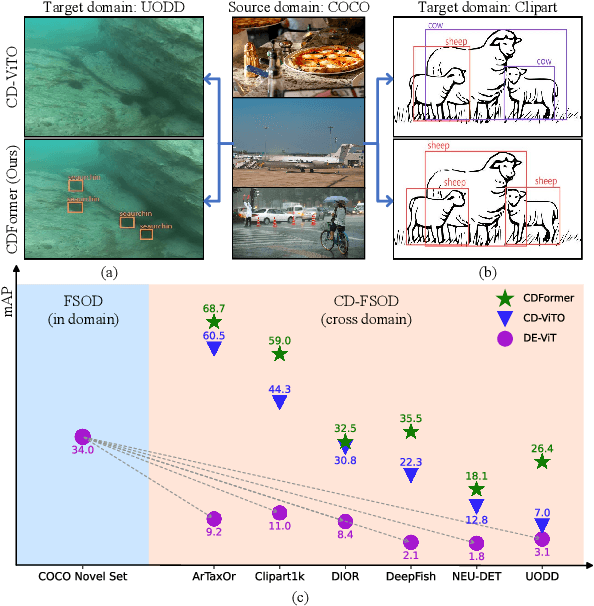
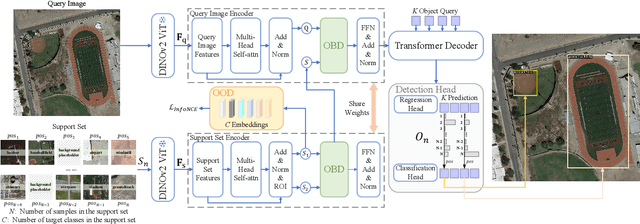

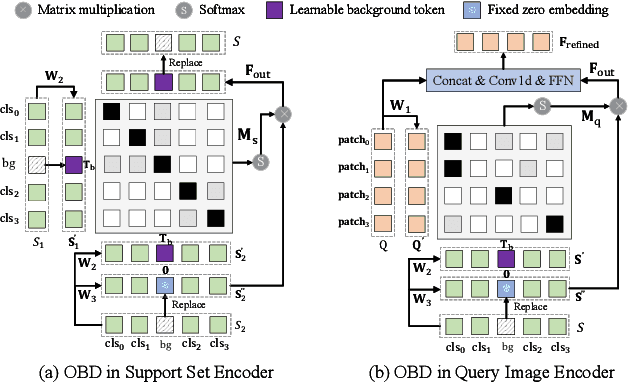
Abstract:Cross-domain few-shot object detection (CD-FSOD) aims to detect novel objects across different domains with limited class instances. Feature confusion, including object-background confusion and object-object confusion, presents significant challenges in both cross-domain and few-shot settings. In this work, we introduce CDFormer, a cross-domain few-shot object detection transformer against feature confusion, to address these challenges. The method specifically tackles feature confusion through two key modules: object-background distinguishing (OBD) and object-object distinguishing (OOD). The OBD module leverages a learnable background token to differentiate between objects and background, while the OOD module enhances the distinction between objects of different classes. Experimental results demonstrate that CDFormer outperforms previous state-of-the-art approaches, achieving 12.9% mAP, 11.0% mAP, and 10.4% mAP improvements under the 1/5/10 shot settings, respectively, when fine-tuned.
Doracamom: Joint 3D Detection and Occupancy Prediction with Multi-view 4D Radars and Cameras for Omnidirectional Perception
Jan 26, 2025



Abstract:3D object detection and occupancy prediction are critical tasks in autonomous driving, attracting significant attention. Despite the potential of recent vision-based methods, they encounter challenges under adverse conditions. Thus, integrating cameras with next-generation 4D imaging radar to achieve unified multi-task perception is highly significant, though research in this domain remains limited. In this paper, we propose Doracamom, the first framework that fuses multi-view cameras and 4D radar for joint 3D object detection and semantic occupancy prediction, enabling comprehensive environmental perception. Specifically, we introduce a novel Coarse Voxel Queries Generator that integrates geometric priors from 4D radar with semantic features from images to initialize voxel queries, establishing a robust foundation for subsequent Transformer-based refinement. To leverage temporal information, we design a Dual-Branch Temporal Encoder that processes multi-modal temporal features in parallel across BEV and voxel spaces, enabling comprehensive spatio-temporal representation learning. Furthermore, we propose a Cross-Modal BEV-Voxel Fusion module that adaptively fuses complementary features through attention mechanisms while employing auxiliary tasks to enhance feature quality. Extensive experiments on the OmniHD-Scenes, View-of-Delft (VoD), and TJ4DRadSet datasets demonstrate that Doracamom achieves state-of-the-art performance in both tasks, establishing new benchmarks for multi-modal 3D perception. Code and models will be publicly available.
Language Driven Occupancy Prediction
Nov 25, 2024



Abstract:We introduce LOcc, an effective and generalizable framework for open-vocabulary occupancy (OVO) prediction. Previous approaches typically supervise the networks through coarse voxel-to-text correspondences via image features as intermediates or noisy and sparse correspondences from voxel-based model-view projections. To alleviate the inaccurate supervision, we propose a semantic transitive labeling pipeline to generate dense and finegrained 3D language occupancy ground truth. Our pipeline presents a feasible way to dig into the valuable semantic information of images, transferring text labels from images to LiDAR point clouds and utimately to voxels, to establish precise voxel-to-text correspondences. By replacing the original prediction head of supervised occupancy models with a geometry head for binary occupancy states and a language head for language features, LOcc effectively uses the generated language ground truth to guide the learning of 3D language volume. Through extensive experiments, we demonstrate that our semantic transitive labeling pipeline can produce more accurate pseudo-labeled ground truth, diminishing labor-intensive human annotations. Additionally, we validate LOcc across various architectures, where all models consistently outperform state-ofthe-art zero-shot occupancy prediction approaches on the Occ3D-nuScenes dataset. Notably, even based on the simpler BEVDet model, with an input resolution of 256 * 704,Occ-BEVDet achieves an mIoU of 20.29, surpassing previous approaches that rely on temporal images, higher-resolution inputs, or larger backbone networks. The code for the proposed method is available at https://github.com/pkqbajng/LOcc.
RestorerID: Towards Tuning-Free Face Restoration with ID Preservation
Nov 21, 2024



Abstract:Blind face restoration has made great progress in producing high-quality and lifelike images. Yet it remains challenging to preserve the ID information especially when the degradation is heavy. Current reference-guided face restoration approaches either require face alignment or personalized test-tuning, which are unfaithful or time-consuming. In this paper, we propose a tuning-free method named RestorerID that incorporates ID preservation during face restoration. RestorerID is a diffusion model-based method that restores low-quality images with varying levels of degradation by using a single reference image. To achieve this, we propose a unified framework to combine the ID injection with the base blind face restoration model. In addition, we design a novel Face ID Rebalancing Adapter (FIR-Adapter) to tackle the problems of content unconsistency and contours misalignment that are caused by information conflicts between the low-quality input and reference image. Furthermore, by employing an Adaptive ID-Scale Adjusting strategy, RestorerID can produce superior restored images across various levels of degradation. Experimental results on the Celeb-Ref dataset and real-world scenarios demonstrate that RestorerID effectively delivers high-quality face restoration with ID preservation, achieving a superior performance compared to the test-tuning approaches and other reference-guided ones. The code of RestorerID is available at \url{https://github.com/YingJiacheng/RestorerID}.
SCPNet: Unsupervised Cross-modal Homography Estimation via Intra-modal Self-supervised Learning
Jul 11, 2024



Abstract:We propose a novel unsupervised cross-modal homography estimation framework based on intra-modal Self-supervised learning, Correlation, and consistent feature map Projection, namely SCPNet. The concept of intra-modal self-supervised learning is first presented to facilitate the unsupervised cross-modal homography estimation. The correlation-based homography estimation network and the consistent feature map projection are combined to form the learnable architecture of SCPNet, boosting the unsupervised learning framework. SCPNet is the first to achieve effective unsupervised homography estimation on the satellite-map image pair cross-modal dataset, GoogleMap, under [-32,+32] offset on a 128x128 image, leading the supervised approach MHN by 14.0% of mean average corner error (MACE). We further conduct extensive experiments on several cross-modal/spectral and manually-made inconsistent datasets, on which SCPNet achieves the state-of-the-art (SOTA) performance among unsupervised approaches, and owns 49.0%, 25.2%, 36.4%, and 10.7% lower MACEs than the supervised approach MHN. Source code is available at https://github.com/RM-Zhang/SCPNet.
Rethinking Early-Fusion Strategies for Improved Multispectral Object Detection
May 25, 2024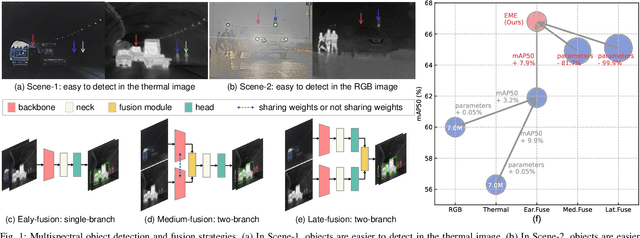
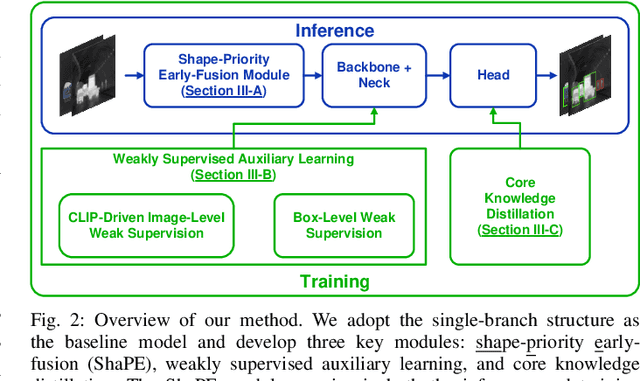

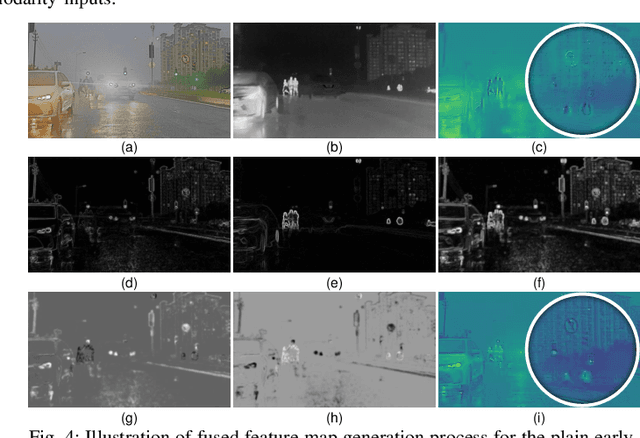
Abstract:Most recent multispectral object detectors employ a two-branch structure to extract features from RGB and thermal images. While the two-branch structure achieves better performance than a single-branch structure, it overlooks inference efficiency. This conflict is increasingly aggressive, as recent works solely pursue higher performance rather than both performance and efficiency. In this paper, we address this issue by improving the performance of efficient single-branch structures. We revisit the reasons causing the performance gap between these structures. For the first time, we reveal the information interference problem in the naive early-fusion strategy adopted by previous single-branch structures. Besides, we find that the domain gap between multispectral images, and weak feature representation of the single-branch structure are also key obstacles for performance. Focusing on these three problems, we propose corresponding solutions, including a novel shape-priority early-fusion strategy, a weakly supervised learning method, and a core knowledge distillation technique. Experiments demonstrate that single-branch networks equipped with these three contributions achieve significant performance enhancements while retaining high efficiency. Our code will be available at \url{https://github.com/XueZ-phd/Efficient-RGB-T-Early-Fusion-Detection}.
SGDFormer: One-stage Transformer-based Architecture for Cross-Spectral Stereo Image Guided Denoising
Mar 30, 2024



Abstract:Cross-spectral image guided denoising has shown its great potential in recovering clean images with rich details, such as using the near-infrared image to guide the denoising process of the visible one. To obtain such image pairs, a feasible and economical way is to employ a stereo system, which is widely used on mobile devices. Current works attempt to generate an aligned guidance image to handle the disparity between two images. However, due to occlusion, spectral differences and noise degradation, the aligned guidance image generally exists ghosting and artifacts, leading to an unsatisfactory denoised result. To address this issue, we propose a one-stage transformer-based architecture, named SGDFormer, for cross-spectral Stereo image Guided Denoising. The architecture integrates the correspondence modeling and feature fusion of stereo images into a unified network. Our transformer block contains a noise-robust cross-attention (NRCA) module and a spatially variant feature fusion (SVFF) module. The NRCA module captures the long-range correspondence of two images in a coarse-to-fine manner to alleviate the interference of noise. The SVFF module further enhances salient structures and suppresses harmful artifacts through dynamically selecting useful information. Thanks to the above design, our SGDFormer can restore artifact-free images with fine structures, and achieves state-of-the-art performance on various datasets. Additionally, our SGDFormer can be extended to handle other unaligned cross-model guided restoration tasks such as guided depth super-resolution.
 Add to Chrome
Add to Chrome Add to Firefox
Add to Firefox Add to Edge
Add to Edge